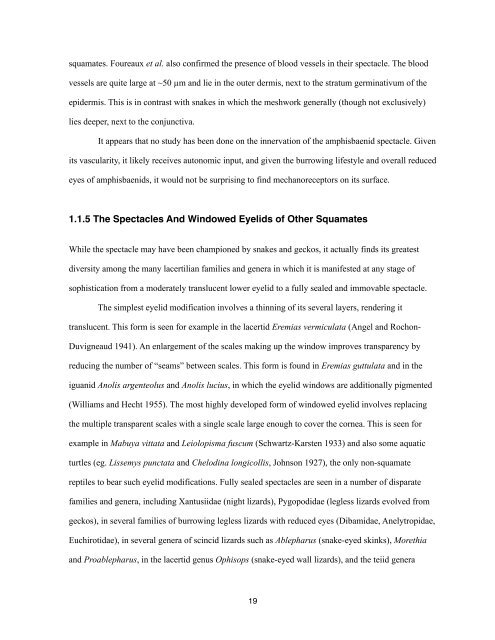Chapter 1, The Reptilian Spectacle - UWSpace - University of ...
Chapter 1, The Reptilian Spectacle - UWSpace - University of ...
Chapter 1, The Reptilian Spectacle - UWSpace - University of ...
You also want an ePaper? Increase the reach of your titles
YUMPU automatically turns print PDFs into web optimized ePapers that Google loves.
squamates. Foureaux et al. also confirmed the presence <strong>of</strong> blood vessels in their spectacle. <strong>The</strong> blood<br />
vessels are quite large at ~50 µm and lie in the outer dermis, next to the stratum germinativum <strong>of</strong> the<br />
epidermis. This is in contrast with snakes in which the meshwork generally (though not exclusively)<br />
lies deeper, next to the conjunctiva.<br />
It appears that no study has been done on the innervation <strong>of</strong> the amphisbaenid spectacle. Given<br />
its vascularity, it likely receives autonomic input, and given the burrowing lifestyle and overall reduced<br />
eyes <strong>of</strong> amphisbaenids, it would not be surprising to find mechanoreceptors on its surface.<br />
1.1.5 <strong>The</strong> <strong>Spectacle</strong>s And Windowed Eyelids <strong>of</strong> Other Squamates<br />
While the spectacle may have been championed by snakes and geckos, it actually finds its greatest<br />
diversity among the many lacertilian families and genera in which it is manifested at any stage <strong>of</strong><br />
sophistication from a moderately translucent lower eyelid to a fully sealed and immovable spectacle.<br />
<strong>The</strong> simplest eyelid modification involves a thinning <strong>of</strong> its several layers, rendering it<br />
translucent. This form is seen for example in the lacertid Eremias vermiculata (Angel and Rochon-<br />
Duvigneaud 1941). An enlargement <strong>of</strong> the scales making up the window improves transparency by<br />
reducing the number <strong>of</strong> “seams” between scales. This form is found in Eremias guttulata and in the<br />
iguanid Anolis argenteolus and Anolis lucius, in which the eyelid windows are additionally pigmented<br />
(Williams and Hecht 1955). <strong>The</strong> most highly developed form <strong>of</strong> windowed eyelid involves replacing<br />
the multiple transparent scales with a single scale large enough to cover the cornea. This is seen for<br />
example in Mabuya vittata and Leiolopisma fuscum (Schwartz-Karsten 1933) and also some aquatic<br />
turtles (eg. Lissemys punctata and Chelodina longicollis, Johnson 1927), the only non-squamate<br />
reptiles to bear such eyelid modifications. Fully sealed spectacles are seen in a number <strong>of</strong> disparate<br />
families and genera, including Xantusiidae (night lizards), Pygopodidae (legless lizards evolved from<br />
geckos), in several families <strong>of</strong> burrowing legless lizards with reduced eyes (Dibamidae, Anelytropidae,<br />
Euchirotidae), in several genera <strong>of</strong> scincid lizards such as Ablepharus (snake-eyed skinks), Morethia<br />
and Proablepharus, in the lacertid genus Ophisops (snake-eyed wall lizards), and the teiid genera<br />
19
















